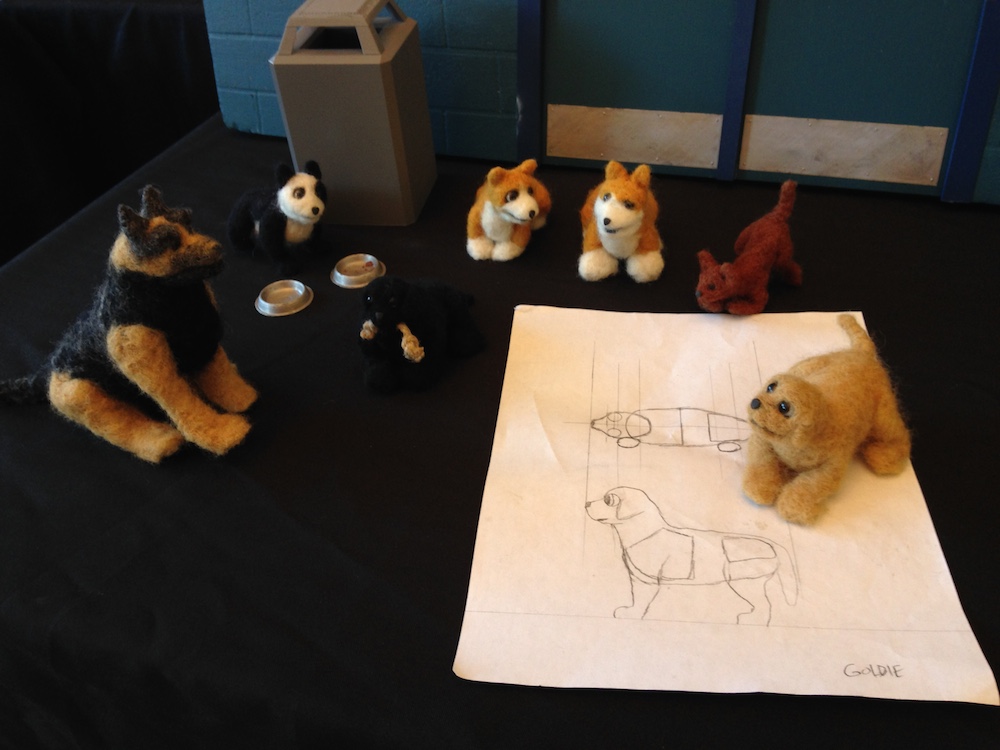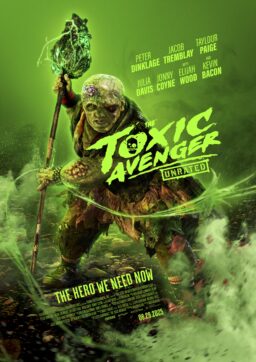The following article completes our coverage of this year’s Pens to Lens Gala in Champaign-Urbana (click here for Part I). For the fifth year in a row, students ranging from kindergarten age to twelfth grade submitted their own scripts to the Pens to Lens Screenwriting Competition. Sixteen of the scripts were selected by directors from Champaign Movie Makers to be produced, while three student-made films were awarded special prizes. The completed slate of short films spawned from this contest, organized by the Champaign Urbana Film Society, were screened this past Saturday in a two-part program at the Virginia Theatre (click on each bolded title and you’ll be directed to the full short).
CHAPTER THREE: “STOP-MOTION MARVELS”
Few films this year, short or otherwise, have brought me to tears as masterfully as third-grader Claire Hartman’s “The Puppy Trials,” an extraordinary stop-motion short directed by Thomas and Becky Nicol. It centers on Big Jim (voiced by Greg Williams), an aging dog who instructs the puppies in an animal shelter on how to be well-behaved when surveyed by potential owners. With delicate nuance and startling emotion, the film celebrates the innate need for companionship shared by humans and canines. Though Thomas had been animating from an early age, it wasn’t until he took a class taught by LAIKA animator Justin Rasch that he was able to graduate from animating at 12 frames per second to 24 frames per second, resulting in movement that is richly textured. The structure of the dogs’ faces prevented them from smiling, allowing the emotion to be conveyed in ways that are more authentically animal-like.
“Structurally we were inspired by Gromit from ‘Wallace and Gromit,’” said Becky. “We wanted Big Jim to express emotion through his eyebrows because the majority of his face is stationary. He resembles a German Shepherd who had been a police dog, and Tom animated him with a limp, indicating that his hip may have been injured when he was on the force.”
Each dog consisted of a wire armature fleshed out with foam soaked in liquid latex that could be molded like clay. Becky handled the needle felting process for each dog’s outward appearance, which took three to four hours on average. Thomas confessed that the puppies looked far less adorable before their eyes were popped into their sockets.
“Becky left the faces for last because of all the detail work they entailed,” said Thomas, “That meant the back end was this fully fleshed-out, cute little puppy butt, and on the front was this horrific black eyeless skull just staring into your soul.”
CHAPTER FOUR: “A CASE OF THE CREEPS”
Speaking of horror, this year’s Pens to Lens offered three first-rate entries in the genre, all of which showcased the versatile work of eleventh grader Parker Evans. Evans wrote the cautionary sci-fi short, “Hu-Man,” a taut little gem that pays clever homage to the HAL robot (famously birthed in Urbana) from “2001: A Space Odyssey.” Director Robin Berthier drew inspiration from the dramatic framing in “Mr. Robot” to create a sense of unease, while keeping the face of the film’s formidable robot shrouded in mystery until the very end, a la “The Twilight Zone.” The white walls and glass spectator window of a squash court at the university were ingeniously used as the scientists’ lab, while young actress Sofie Skottene was cast as the androgynous robot, a Star Child for the apocalypse.
Evans was also the third filmmaker this year to earn a prize in the Student Filmmaking Competition for his own directorial debut, “Red Letter Psychics: The Ghost Mask.” He told me that it was purely a coincidence that the apparition hidden behind an expressionless white mask in his film was nearly identical to the one he portrayed in Scott A. Best’s “Daniel,” the scariest and most pleasingly cinematic treasure of Pens to Lens 2017. Director John Isberg pulled off a staggering tribute to “The Shining” by filming an overhead shot of a car via a drone as it drove down the road at night. The shot is repeated at the end with a credit roll identical to the one featured in Kubrick’s 1980 masterpiece. Best certainly had that film in mind when he penned this psychological portrait of a schizophrenic man (Kyle A. Thomas) coming to grips with the loss of his brother (David Schiller).
“‘The Shining’ was the film that made me want to go into filmmaking,” said Best. “That movie has been analyzed so much, and yet people are still debating the true meaning of the story. If I can make a film that gets people thinking like that, then I would be happy to do that for the rest of my life.”
After stumbling upon a ragged print of Tom McLoughlin’s 1982 creeper, “One Dark Night,” Isberg decided to lend a similar aesthetic to “Daniel,” complete with cigarette burns. He grew up on horror films from that period (“the more off-kilter, the better”) that specialized in tricking audiences into thinking they were watching something with money behind it. Isberg cited John Carpenter’s decision to shoot “Halloween” in anamorphic as a key example of using budgetary limitations to one’s advantage. Yet apart from the seduction of the style, Isberg was drawn to the script for a deeper reason.
“It’s a film about someone who is overcoming a lot of trauma,” said Isberg. “I teach kids who’ve had to deal with trauma, and I’ve had to overcome trauma in my own life. I actually cut a line in the script because it was too close to my own situation. There are people or events in your life that you build up in your mind until they are everywhere. People who suffer from PTSD sometimes have to be told repeatedly that something isn’t real in order to be brought back into reality.”
CHAPTER FIVE: “HAIL TO THE CHIEF”
If there’s one apparition still haunting the grounds of the city’s university, it is most certainly that of Chief Illiniwek, the school’s controversial mascot that was officially banned in 2007, yet still materializes encased in glass at bars on campus a decade later. Rather than educate the masses about Native American history, the mascot served as a commercial product that proved offensive for members of the culture that it was supposedly honoring. By far the most important and incendiary film at this year’s Pens to Lens was Gabriela Ines DeLisle Diaz’s “Standing Rock 19,000, Mascots 0,” which lampoons the hypocritical outrage of Chief fans faced with the death of their tradition. The film was directed by Rachel Rebecca Berry, who collaborated with Diaz last year on “Fast Rodney Who Was On His Way Out,” which I hailed as “a riveting meditation on race, class and other barriers that are continuously preventing us from understanding one another.” The “19,000” in the title of Diaz’s latest film is a reference to the number of protestors who gathered to try and stop the Dakota Access Pipeline, an event very close to the writer’s heart.
“I had considered applying to the UIUC for a long time, until I saw all these Chief Illiniwek shirts being cranked out while the Dakota Access Pipeline protests were occurring,” said Diaz. “I don’t think Obama did as much as he should’ve in protecting the Standing Rock reservation, and this film was spawned from that frustration. For a lot of alumni, the Chief represents nothing but nostalgia for their school and their own memories. I’ve noticed that the younger generations are much more aware and politically correct in their views about these traditions.”
Whereas “Fast Rodney” took the form of near wordless poetry, “Standing Rock” consists primarily of a debate between two female Native American students and a white male peer at a basketball game filled with fans decked out in Chief costumes. The women’s dialogue is loaded with biting retorts such as, “I can’t think of a better way to honor the people who you removed from this land than by pretending to be them,” while Berry plays with the form in ways that reminded me of Spike Lee’s more overtly satirical work. She made the inspired choice of having various minor characters in the crowd and on the court break the fourth wall and deliver their lines straight to the audience, forcing us to confront our implicit role in the conflict. Berry told me that her biggest apprehension about making the film was the fact that she knows many people—including her own mom—who are supportive of the Chief. Her father also happens to be from Cleveland and still cheers on the Cleveland Indians, though he acknowledges that their logo of Chief Wahoo is problematic and needs to change.
“Gabriela said she felt bad after submitting the script because she thought it should’ve been toned down in order to be more persuasive,” said Berry. “But I felt like the script wasn’t trying to persuade people. It was expressing Gabby’s frustration with having these sorts of conversations, so I wanted to give it a sense of realism that devolves into absurdity, because the situation is absurd. One of my favorite shots is the little girl in the Chief makeup who’s shaking her head in disgust. All the adults around her are acting just like little kids. Half of Gabby’s family is from Guam, and she has a lot of anger about the military installations there, as well as the lack of representation for its citizens, since they can’t vote for president. Gabby’s script explores the issue of representation in a way that is so thoughtful and so articulate that you can’t believe it was written by a 17-year-old.”
For more info on Pens to Lens, visit the gala’s official site as well as its YouTube and Facebook pages.












